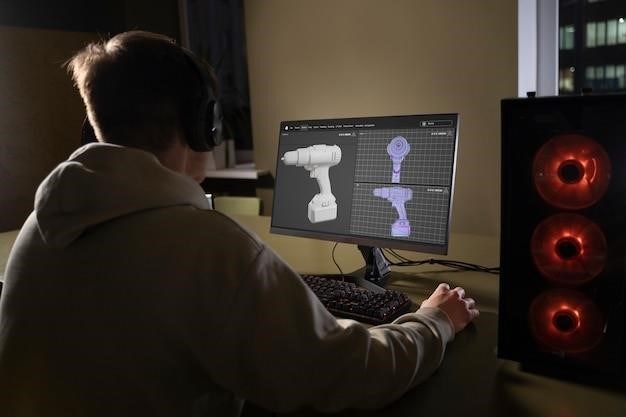EpiScanpy Tutorial⁚ A Comprehensive Guide to Epigenomic Single-Cell Analysis
This comprehensive tutorial provides a step-by-step guide to analyzing single-cell epigenomic data using EpiScanpy, a powerful toolkit for analyzing single-cell open chromatin (scATAC-seq) and single-cell DNA methylation (scBS-seq) data. We’ll explore various aspects of EpiScanpy, including installation, data loading, feature space construction, nearest neighbor graph construction, clustering, cell type identification, trajectory inference, visualization, and interpretation. Through illustrative case studies, we’ll demonstrate EpiScanpy’s capabilities in analyzing human PBMCs and mouse frontal cortex data. This tutorial is designed for researchers seeking to leverage the power of EpiScanpy for their epigenomic single-cell analysis needs.
Introduction to EpiScanpy
EpiScanpy is a powerful and versatile toolkit designed for the analysis of single-cell epigenomic data, specifically single-cell DNA methylation and single-cell ATAC-seq data. It stands as the epigenomic extension of the widely acclaimed scRNA-seq analysis tool, Scanpy (Genome Biology, 2018), offering a comprehensive suite of functionalities for exploring the intricate regulatory landscape of the epigenome at the single-cell level. EpiScanpy’s capabilities extend beyond traditional scRNA-seq analysis, enabling researchers to delve into the complexities of epigenomic modifications, including DNA methylation patterns and chromatin accessibility.
EpiScanpy effectively addresses the unique challenges posed by epigenomic data by employing a multifaceted approach. It leverages multiple feature space constructions to quantify the epigenome, providing a nuanced understanding of the underlying regulatory mechanisms. This allows for a comprehensive representation of the epigenomic landscape, capturing both global and local variations in epigenetic modifications. Furthermore, EpiScanpy utilizes epigenomic distance metrics to construct nearest neighbor graphs, which effectively capture the relationships between cells based on their epigenomic profiles. These graphs serve as a foundation for downstream analyses, facilitating the identification of cell clusters, the reconstruction of developmental trajectories, and the exploration of cell-cell interactions.
The significance of EpiScanpy lies in its ability to unlock the potential of single-cell epigenomic data, providing researchers with a robust platform for uncovering hidden regulatory mechanisms, identifying cell subtypes, and unraveling the complexities of epigenetic regulation in health and disease. Whether you’re investigating the dynamic interplay of DNA methylation in development or exploring the role of chromatin accessibility in disease pathogenesis, EpiScanpy equips you with the necessary tools to navigate the intricacies of the epigenome at a single-cell resolution.
Installation and Setup
Installing EpiScanpy is a straightforward process that can be accomplished using the popular package manager, conda. To install EpiScanpy, you can use the following command⁚
conda install -c conda-forge episcanpy
This command will download and install EpiScanpy along with its dependencies, ensuring that you have all the necessary components for your analysis. Alternatively, you can install EpiScanpy from source by cloning the GitHub repository and running the setup script.
git clone https://github.com/columemaria/episcanpy.git
cd episcanpy
pip install -e .
Once EpiScanpy is installed, you can import it into your Python environment and begin your analysis. You can verify the successful installation by running the following command in your Python environment⁚
import episcanpy as epi
If the import is successful, you are ready to start using EpiScanpy for your epigenomic single-cell analysis.
For detailed documentation and tutorials, you can refer to the official EpiScanpy documentation on ReadTheDocs.io. The documentation provides comprehensive instructions on how to use EpiScanpy effectively, covering a wide range of functionalities and analysis workflows. You can also find tutorials and live demos on CodeOcean, which offer practical examples and guidance for applying EpiScanpy to real-world datasets.
Data Loading and Preprocessing
The initial step in analyzing single-cell epigenomic data using EpiScanpy involves loading and preprocessing your data. EpiScanpy offers flexible data loading capabilities, allowing you to work with various input formats, including count matrices, peak matrices, and methylation matrices. You can load your data using the epi.read_mtx function, specifying the path to your data file.
adata = epi.read_mtx('path/to/your/data.mtx')
Once your data is loaded, preprocessing is crucial to ensure data quality and prepare it for downstream analysis. EpiScanpy provides a set of preprocessing functions to handle various aspects of data cleaning and normalization. These functions include⁚
- Filtering⁚ Removing cells or features with low counts or poor quality.

- Normalization⁚ Adjusting for differences in sequencing depth or library size.
- Dimensionality Reduction⁚ Reducing the dimensionality of the data while preserving important biological information.
You can apply these preprocessing steps using functions like epi.pp.filter_cells, epi.pp.normalize_counts, and epi.pp.pca. EpiScanpy’s preprocessing capabilities are tailored to handle the unique characteristics of single-cell epigenomic data, ensuring accurate and robust analysis.
For example, to filter cells based on the number of detected features, you can use⁚
epi.pp.filter_cells(adata, min_features=1000)
This command will remove cells with fewer than 1000 detected features, enhancing the quality of your analysis.
Feature Space Construction
Feature space construction is a fundamental step in analyzing single-cell epigenomic data, enabling the identification of meaningful biological patterns and insights. EpiScanpy offers a range of feature space construction methods tailored to the specific characteristics of scATAC-seq and scBS-seq data.
For scATAC-seq data, EpiScanpy allows you to construct feature spaces based on genomic regions, such as⁚
- Windows⁚ Dividing the genome into equal-sized windows, providing a simple and efficient way to quantify accessibility across the genome.
- Promoters⁚ Focusing on regions upstream of genes, capturing the regulatory landscape associated with gene expression.
- Enhancers⁚ Identifying potential regulatory elements involved in gene activation.
For scBS-seq data, EpiScanpy supports feature space construction based on⁚
- CpG sites⁚ Quantifying methylation levels at individual CpG sites, offering a detailed view of methylation patterns across the genome.
- CpG islands⁚ Focusing on regions with high CpG density, providing insights into methylation patterns associated with gene regulation.
The choice of feature space construction method depends on the specific research question and data characteristics. EpiScanpy provides flexible tools to allow researchers to customize feature space construction based on their needs. You can use functions like epi.pp.build_feature_space to construct the desired feature space.
For instance, to construct a feature space based on 10kb windows⁚
epi.pp.build_feature_space(adata, feature_type='windows', window_size=10000)
This command will create a feature space consisting of 10kb windows across the genome, allowing for a comprehensive analysis of chromatin accessibility patterns.
Nearest Neighbor Graph Construction
Nearest neighbor graph construction is a crucial step in single-cell epigenomic analysis, enabling the identification of relationships and similarities between cells based on their epigenomic profiles. EpiScanpy leverages the power of graph-based methods to represent the complex relationships between cells, facilitating downstream analyses like clustering and trajectory inference.
EpiScanpy employs different distance metrics to calculate the similarity between cells in the constructed feature space. These metrics capture the unique characteristics of scATAC-seq and scBS-seq data, ensuring accurate representation of epigenomic relationships. For scATAC-seq data, EpiScanpy uses metrics like Jaccard distance, which considers the overlap between accessible regions in different cells, and Kullback-Leibler divergence, which measures the difference in the distribution of accessible regions between cells. For scBS-seq data, EpiScanpy utilizes metrics like Manhattan distance or Euclidean distance to quantify the difference in methylation levels between cells.
Once the distance between cells has been calculated, EpiScanpy constructs a nearest neighbor graph, connecting cells based on their epigenomic similarity. This graph provides a powerful representation of the underlying structure of the single-cell epigenomic data, revealing clusters of cells with similar epigenomic profiles and potential developmental trajectories.
The nearest neighbor graph can be constructed using functions like epi.pp.neighbors, which takes the input data and the chosen distance metric as parameters. For example, to construct a nearest neighbor graph based on Jaccard distance⁚
epi.pp.neighbors(adata, metric='jaccard')
This command will compute the Jaccard distance between cells and build a nearest neighbor graph, providing a foundation for further analysis and interpretation.
Clustering and Cell Type Identification
Clustering is a fundamental step in single-cell epigenomic analysis, allowing researchers to group cells with similar epigenomic profiles, providing insights into cell populations and their underlying heterogeneity. EpiScanpy offers a range of powerful clustering algorithms to identify distinct cell types within the data. These algorithms leverage the nearest neighbor graph previously constructed, efficiently grouping cells based on their epigenomic similarity.
One popular clustering algorithm available in EpiScanpy is Leiden clustering. This algorithm iteratively refines cluster assignments by considering the connections between cells in the nearest neighbor graph, resulting in robust and biologically meaningful clusters. Leiden clustering is particularly effective in handling complex datasets with intricate cell type relationships.
To perform Leiden clustering using EpiScanpy, the epi.tl.leiden function can be employed. This function takes the input data and optional parameters like the resolution parameter, which controls the granularity of the clustering, as arguments. For instance, to perform Leiden clustering with a resolution of 1⁚
epi.tl.leiden(adata, resolution=1)
This command will perform Leiden clustering on the data, assigning each cell to a specific cluster based on its epigenomic profile. The resulting cluster assignments can then be visualized and interpreted to identify distinct cell populations.
Beyond clustering, EpiScanpy also provides tools for identifying cell types based on known marker genes. By leveraging publicly available databases of marker genes for specific cell types, EpiScanpy can assign cell type labels to clusters, providing further insight into the composition and function of each cell population. This functionality enables researchers to confidently identify cell types within their data, enhancing the interpretation of their findings.
Trajectory Inference
Trajectory inference is a powerful technique used to infer developmental or differentiation pathways from single-cell epigenomic data. By analyzing changes in epigenetic landscapes across cells, researchers can reconstruct the dynamic processes underlying cell fate decisions. EpiScanpy offers a suite of trajectory inference algorithms, enabling users to explore the temporal dynamics of epigenomic changes and gain insights into cellular differentiation and developmental trajectories.
One prominent trajectory inference algorithm available in EpiScanpy is PAGA (Partition-based Graph Abstraction). This algorithm constructs a simplified representation of the nearest neighbor graph, identifying branching points and major paths of cellular development. PAGA effectively captures the global structure of the trajectory while reducing the complexity of the data, allowing researchers to gain a clearer understanding of the underlying developmental processes.
To perform PAGA trajectory inference using EpiScanpy, the epi.tl.paga function can be employed. This function takes the input data and optional parameters like the grouping parameter, which specifies the level of aggregation, as arguments. For instance, to perform PAGA trajectory inference with a grouping level of 10⁚
epi.tl.paga(adata, groups="leiden", group_by="leiden", n_neighbors=10)
This command will perform PAGA trajectory inference on the data, considering the Leiden cluster assignments for grouping. The resulting trajectory can then be visualized and interpreted to reveal branching points, major developmental pathways, and potential cell fate transitions.
Beyond PAGA, EpiScanpy also supports other trajectory inference algorithms like SLICER (Single-cell Lineage Inference using Cell-cycle and Regulatory Elements) and DPT (Diffusion Pseudotime), providing researchers with a comprehensive set of tools to explore the temporal dynamics of epigenomic changes. By leveraging these algorithms, researchers can gain valuable insights into the intricate processes underlying cell fate decisions and developmental trajectories.
Visualization and Interpretation
Visualization plays a crucial role in understanding and interpreting the complex data generated by single-cell epigenomic analysis. EpiScanpy offers a wide range of visualization tools, allowing researchers to explore and communicate their findings effectively. These tools enable the visualization of various aspects of the data, including cell type distribution, differential accessibility, and developmental trajectories.
One powerful visualization tool in EpiScanpy is the epi.pl.umap function. This function generates a Uniform Manifold Approximation and Projection (UMAP) plot, which projects high-dimensional data into a two-dimensional space while preserving the neighborhood relationships between cells. UMAP plots are highly effective in visualizing the global structure of the data, revealing clusters of cells with similar epigenomic profiles.
To create a UMAP plot using EpiScanpy, simply call the epi.pl.umap function with the desired parameters. For instance, to generate a UMAP plot colored by cell type⁚

epi.pl.umap(adata, color="cell_type")
This command will create a UMAP plot where each cell is colored according to its assigned cell type. This visualization allows researchers to identify clusters of cells with similar epigenomic profiles and relate those clusters to specific cell types.
Beyond UMAP plots, EpiScanpy offers a rich library of visualization tools, including heatmaps for visualizing gene expression or accessibility patterns, violin plots for comparing distributions of features across different cell types, and trajectory plots for visualizing developmental pathways. These tools provide researchers with a flexible and powerful set of options for exploring and communicating their findings from single-cell epigenomic analysis.
Case Study⁚ scATAC-seq Analysis of Human PBMCs
This case study demonstrates EpiScanpy’s application in analyzing scATAC-seq data from human peripheral blood mononuclear cells (PBMCs). The dataset, derived from Buenrostro et al. (2018), comprises 3000 PBMCs, providing a rich foundation for exploring the epigenomic landscape of these diverse cell types. The tutorial delves into preprocessing, clustering, cell type identification, and trajectory inference, showcasing EpiScanpy’s capabilities in uncovering intricate relationships between epigenomic profiles and cell identity.
The initial step involves preprocessing the raw scATAC-seq data, which includes filtering low-quality cells, removing duplicate reads, and aligning reads to the reference genome. EpiScanpy’s tools facilitate these tasks, ensuring the data is ready for further analysis. Next, EpiScanpy constructs a count matrix, a representation of the accessibility of genomic regions across all cells. This matrix forms the foundation for downstream analyses.
To identify distinct cell populations within the PBMC data, EpiScanpy employs clustering algorithms. These algorithms group cells based on similarities in their epigenomic profiles, revealing distinct cell types within the PBMC population. The tutorial then explores cell type identification, leveraging known marker genes to assign cell types to the identified clusters.
Finally, the tutorial delves into trajectory inference, a powerful tool for understanding developmental pathways and cell fate transitions. EpiScanpy’s trajectory inference algorithms reconstruct the developmental paths taken by individual cells, providing insights into the dynamics of epigenomic changes during differentiation. This case study exemplifies the power of EpiScanpy in unraveling the complexity of scATAC-seq data, facilitating the identification of cell types, and elucidating the underlying epigenomic mechanisms of cell differentiation.



